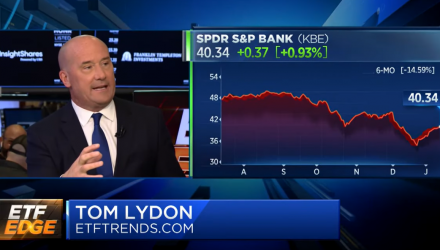“It’s actively managed,” said Lydon. “It’s got robotics, AI, DNA-genome sequencing–areas of the market where if you’re looking for the future of technology stocks, it’s all here.”
Niche ETFs Getting Even Narrower?
As investors grow more familiar with ETFs, many are using targeted ETF strategies to gain focused exposure to specific market themes and potential opportunity sets. In fact, the New York Times published an article saying that niche ETFs are getting narrower, attracting investors to a specific corner of the market without any actual profit potential.
It speaks to the case for diversification from single-stock investing via an ETF, but is the thematic space going too far and getting too niche?
“Diversification for the average investors makes a heck of a lot of sense,” said Lydon.
Lydon argues that like disruptive ETFs, investors can take advantage of investments today that could potentially be the drivers of technology tomorrow.
“What about these new themes that are going to be the future 5 and 10 years later that we can invest in now,” said Lydon.
With ETFs catering to the pet care industry, medical marijuana, gaming, and other niche sectors, it gives investors a wide array of opportunities to not only capture profit potential, but to also cater to investors’ interests.
“Take advantage of what Wall Street has to offer,” said Lydon.
“These are certain areas where if you can do it at a diversified format, it’s worth it for a small amount of your money,” said Lydon.
Model Portfolio to Beat the Market
With 2019 in full swing, investors are looking to adjust their portfolios after a volatile end to 2018 saw U.S. equities finish their worst year in over a decade. As such, a portfolio with a strategic mix of ETFs can not only provide investors with the upside to capture gains in U.S. equities, but also international markets and other areas of growth in 2019.
Lydon proposed the following portfolio:
Invesco S&P 500 Equal Weight ETF (RSP)
- RSP equally weights components, so larger mid-cap tilt at 42.9%
- Benefits from long-term outperformance of smaller-sized S&P 500 companies
Vanguard FTSE Developed Markets ETF (VEA)
- Captures 80% of the available foreign market-cap
- Market-cap weighting, so puts emphasis on largest firms from developed international markets
Schwab Fundamental Emerging Markets Large Company Index ETF (FNDE)
- targeting the emerging markets large-caps then screens the universe based on RAFI’s signature fundamental factors: sales, cash flow, and equity returns to shareholders
- These three metrics are combined to produce a “fundamentally” weighted selection universe
- In practice, this strategy produces material sector tilts—particularly toward energy and away from technology—with a distinct value bias
NuShares Enhanced Yield 1-5 Year U.S. Aggregate Bond ETF (NUSA)
- The Barclays Aggregate Bond Index is more risky that 10 years ago
- NUSA shortens duration and allocates to higher quality bonds, producing greater yield than the Barclays Agg for the same risk
- Avoids a market-cap weighted strategy; instead allocates to higher quality with higher yield bonds
SPDR® Dow Jones® Global Real Estate ETF (RWO)
- Global real estate – 80%ish REITs, 20%ish international developers & non-REIT property developers
- US is 57%
- Includes some emerging market exposure
- Developing markets are adding to global REIT opportunities
SPDR® Gold Trust (GLD)
- Gold provides greater diversification and can help stabilize portfolios during times of volatility
- Most of retail global demand from gold comes from emerging market countries as more citizens move into the middle class
- M&A another indicator of demand – Example as Newmont Mining buying Canadian rival Goldcorp
With an allocation to U.S. equities, developed markets and emerging markets comprising 75 percent of the portfolio, investors gain core exposure to domestic equities as well as take advantage of opportunities overseas. In addition, value-oriented aspects of the capital markets like real estate and commodities are able to capture any upside if a resurgence in these sectors occur in 2019.
“Pure quality over growth in this type of market,” said Lydon.
For more market trends, visit ETF Trends.
